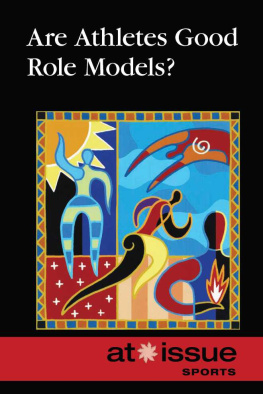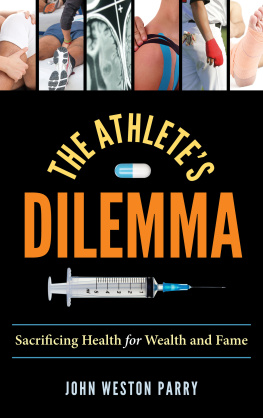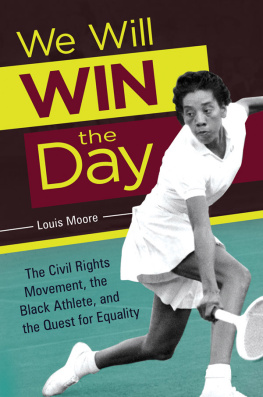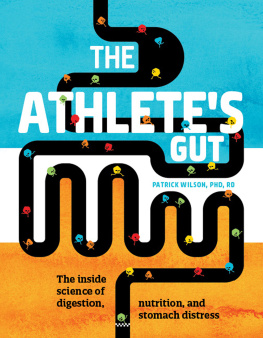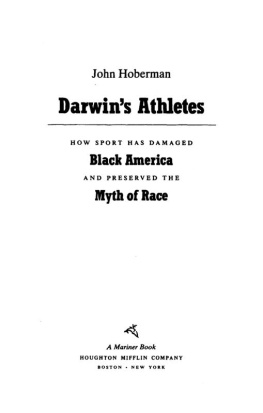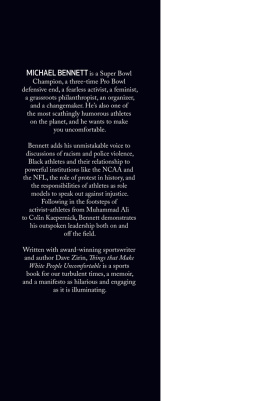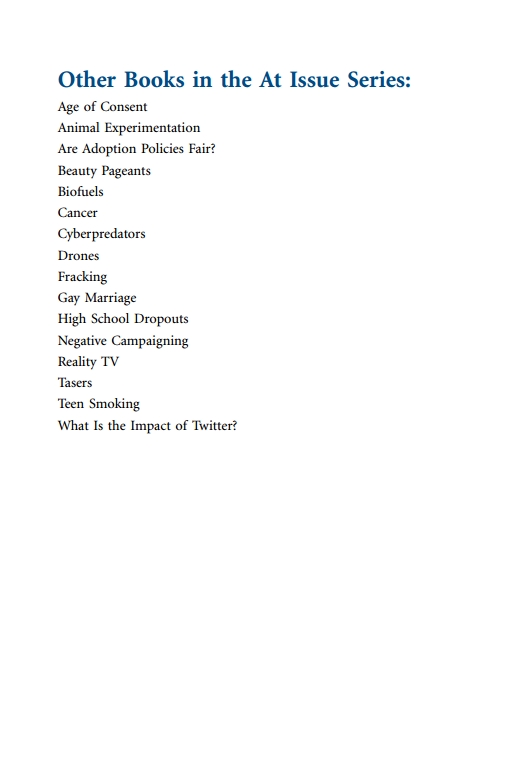Elizabeth Des Chenes, Director, Content Strategy
Cynthia Sanner, Publisher
Douglas Dentino, Manager, New Product
2014 Greenhaven Press, a part of Gale, Cengage Learning
WCN: 01-100-101
Gale and Greenhaven Press are registered trademarks used herein under license.
For more information, contact:
Greenhaven Press 27500 Drake Rd.
Farmington Hills, MI 48331-3535
Or you can visit our Internet site at gale.cengage.com
ALL RIGHTS RESERVED.
No part of this work covered by the copyright herein may be reproduced, transmitted, stored, or used in any form or by any means graphic, electronic, or mechanical, including but not limited to photocopying, recording, scanning, digitizing, taping, Web distribution, information networks, or information storage and retrieval systems, except as permitted under Section 107 or 108 of the 1976 United States Copyright Act, without the prior written permission of the publisher.
For product information and technology assistance, contact us at Gale Customer Support, 1-800-877-4253
For permission to use material from this text or product, submit all requests online at www.cengage.com/permissions
Further permissions questions can be emailed to
Articles in Greenhaven Press anthologies are often edited for length to meet page requirements. In addition, original titles of these works are changed to clearly present the main thesis and to explicitly indicate the author's opinion. Every effort is made to ensure that Greenhaven Press accurately reflects the original intent of the authors. Every effort has been made to trace the owners of copyrighted material.
Cover image GStar.
LIBRARY OF CONGRESS CATALOGING-IN-PUBLICATION DATA
Are athletes good role models? / Thomas Riggs & Company, book editor. p. cm. -- (At issue)
Summary: "At Issue: Are Athletes Good Role Models?: Books in this anthology series focus a wide range of viewpoints onto a single controversial issue, providing in-depth discussions by leading advocates, a quick grounding in the issues, and a challenge to critical thinking skills"-- Provided by publisher. Includes bibliographical references and index.
ISBN 978-0-7377-6820-6 (hardback) -- ISBN 978-0-7377-6821-3 (paperback)
1. Athletes--Conduct of life--Juvenile literature. 2. Role models--Juvenile literature. I. Riggs, Thomas, 1963-GV706.8.A76 2014 306.4'83--dc23
2013038428
Printed in the United States of America 1 2 3 4 5 6 7 18 17 16 15 14
Contents
Leigh Steinberg
Lane Wallace
William C. Rhoden
Mike Tillery
Joe Posnanski
Brendon Ayanbadejo
Bryan Cribb
Mark Galli
Statton
Christopher R. Chase
Leeja Carter
Steve Tobak
Dennis Maley
Introduction
H uman beings have long looked toward athletes for inspiration. The ancient Greeks staged the first Olympic Games in the year 776 bc , competing in foot and chariot races, wrestling matches, and field events such as discus and javelin throws to honor Zeus, the father of the gods. Athletes travelled from as far as Spain to compete in the games, and the winners of each event were crowned with olive wreaths and heralded publically for bringing honor upon their city, their family, and themselves. Often the winners would be commemorated via epinikia victory songs composed by poets exalting the athlete as a paragon of strength and virtueor larger-than-life statues and monuments meant to display the champions superiority. Some ancient Greek historians went so far as to liken Olympic champions to mythological he-roesmortals, often descended from the gods, whose legendary feats of strength and endurance were retold throughout the generations to motivate and instruct young men and women in the meaning of courage, perseverance, and selfconfidence.
Our infatuation with the athletic spectacle continues unabated to this day. Major sporting events such as the modern Olympics, World Cup, Super Bowl, World Series, Stanley Cup playoffs, and the National Collegiate Athletic Association (NCAA) College Basketball Tournament are among the most highly watched and attended sporting contests in the world. A 2011 study by management consulting firm A.T. Kearny found the global sports industry to be worth between $480 billion and $620 billion. A significant portion of that total can be attributed to todays olive wreath, the multimillion dollar endorsement deal that is all but guaranteed to the top athletes in every sport. Another portion comes from the sale of sports paraphernalia and memorabilia, such as authentic jerseys bearing star athletes names, which allow fans to not only show their support for their favorite teams but to imagine that they themselves are the ones scoring the game-winning goal, catching the fifty-yard pass, or pitching the perfect game.
Modern sports stars occupy such a prominent place in our cultural imagination that they are often credited with single-handedly altering the course of history: baseball player Jackie Robinson broke the color barrier in professional sports by becoming the first African American athlete to play major league baseball in 1947, paving the way for the civil rights movement of the 1960s; female tennis player Billie Jean King legitimized womens sports and bolstered the feminist movement by beating male tennis champion Bobby Riggs in the 1973 Battle of the Sexes; the 1980 US mens Olympic ice hockey team gave the United States a crucial psychological edge in the Cold War by defeating the heavily favored Soviet Union team in the Miracle on Ice. Other powerful moments of individual athletic accomplishmentone-handed pitcher Jim Abbott throwing a no-hitter in 1993; Kerri Strug enduring the pain of torn ankle tendons and landing a perfect vault to lead the US womens gymnastics team to their first Olympic gold team medal in 1996; Michael Jordan fighting through the stomach flu (later revealed to be food poisoning) to score thirty-eight points in a pivotal NBA (National Basketball Association) playoff game in 1998stand as contemporary hero myths, cultural touchstones that inspire us to persevere when faced with obstacles of our own.
But with such adulation also comes increased scrutiny. In 1993, outspoken NBA star Charles Barkley decried the increased attention that was being paid to his and other athletes off-court antics in a television commercial, stating, I am not a role model. Im not paid to be a role model. I am paid to wreak havoc on the basketball court. Parents should be role models. Fellow basketball star Karl Malone responded to the ad with a column in Sports Illustrated arguing that, We dont choose to be role models, we are chosen. Our only choice is whether to be a good role model or a bad one. In todays age of the 24/7 news media, cell phone cameras, and social networking sites that allow an individual to snap a photo or a video clip and share it with the world in a matter of seconds, athletes are even more a part of the public eye, and the debate over their rights and responsibilities has intensified.
Some commentators argue that athletes are too driven by greed, ego, and an unhealthy desire to win at all costs to serve as positive examples for the rest of society, particularly when these traits reveal themselves off the court or playing field. Many point to a series of recent scandals related to sports stars as evidence: Pittsburgh Steelers quarterback Ben Roeth-lisberger and Los Angeles Lakers guard Kobe Bryant were accused of sexual assaults in 2010 and 2003, respectively. Seventime Tour de France winner Lance Armstrong was stripped of his titles in 2013 when he admitted to using banned substances in order to get an edge on his opponents, joining baseball players Mark McGwire, Barry Bonds, Sammy Sosa, and Roger Clemens, Olympic sprinter Marion Jones, and several other top-level athletes who have either admitted to or have been strongly suspected of using performance enhancing drugs (PEDs). Superstar golfer Tiger Woods chronic marital infidelities became tabloid fodder in 2009. And Atlanta Falcons quarterback Michael Vick was convicted in 2007 of running an illegal dogfighting ring from his home and spent nineteen months in prison. The list goes on and on, and in almost every case these athletes lost millions of dollars in endorsement contracts while being labeled as villains in the eyes of the once-adoring public.

